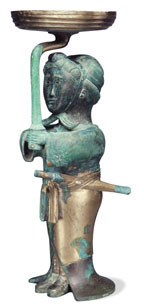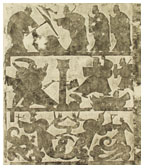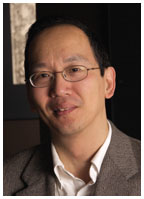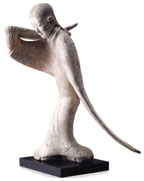Have an opinion about this issue of PAW? Please take a minute to click here and fill out our online questionnaire. It’s an easy way to let the editors know what you like and dislike, and how you think PAW might do better. (All responses will be kept anonymous.) |
March 23, 2005: Features
For the record
The March 23 feature, "An uncertain history," incorrectly identified Wilma Fairbank. The wife of John K. Fairbank, a Harvard professor of modern and contemporary China studies, she was the author of books on Chinese archaeology and architecture.
Standing Soldier Oil Lamp, Chinese Qin or early Western Han Dynasty, ca. 3rd–2nd century B.C. Bronze with cast and engraved designs. (Photograph by Bruce M. White, courtesy PAUM) (PAUM)
This rubbing from a stone at the Wu shrines is part of the museum’s permanent collection. (Photograph by Bruce M. White, courtesy PAUM)
Cary Y. Liu ’78 *97, curator of Asian art at the Art Museum. Rubbings included in the exhibition hang on the walls behind him. (Ricardo Barros)
Sleeve Dancer, Western Han Dynasty. Earthenware with pigments. Private collection. (PAUM) |
![]()
Art exhibition prompts new thinking about an ancient
Chinese site
By Mark F. Bernstein ’83
Hundreds of years of assumptions about an ancient Chinese burial site — and about a defining period in Chinese history — are being called into question because of scholarship presented at a new exhibition at the Princeton University Art Museum. The exhibition, “Recarving China’s Past: Art, Archaeology, and Architecture of the ‘Wu Family Shrines,’” opened March 5 and runs through June 26.
The Wu shrines are believed to be an ancient burial site in Shandong Province in northeastern China. They are believed to date from the late Han Dynasty (206 B.C.—A.D. 220), a period of military expansion, political consolidation, and technological innovation (including the invention of paper and porcelain) that was a turning point in Chinese history. They are believed to have belonged to a family named Wu. But all this is unclear — archaeologists and historians simply do not know the answers. “The whole thing is a question,” says Cary Y. Liu, ’78 *97, curator of Asian art at the museum. Princeton’s exhibition surely will add to that uncertainty.
As one of the few sites dated to the Han Dynasty, the Wu shrines have been a touchstone for the study of that period. Inscriptions and carvings in the shrines have been used to date other tombs and artifacts, and have been essential in understanding Han thought. Although the first known record of inscriptions from the shrines dates to the year 1064, two years before the Norman Conquest of England, the site itself is believed to have been ruined by 13th-century floods, and was not re-excavated until 1786. For most of the last 700 years, scholars and archaeologists hoping to decipher the stone carvings at the sites have relied on a series of ink-on-paper rubbings, including one late-19th-century set in Princeton’s permanent collection that depicts battles, myths, and scenes of filial piety.
But trying to interpret the stones exclusively through the rubbings has proven to be frustrating. One Chinese scholar, He Zhuo (1661—1722), studied the rubbings for years before throwing up his hands in despair. The more materials he gathered, he said, the more their meaning seemed to scatter “like leaves falling.” For one thing, rubbings do not exist for all the stones. Moreover, most scholars, until recently, have tried to interpret the rubbings individually, losing sight of the fact that they were two-dimensional representations of three-dimensional objects that formed an architectural whole.
In a sense, though, a rubbing is more original than the stone itself, in that it captures the surface of the stone at a particular point in time and is unchangeable. Liu has discovered that some of the stones were partially recarved over the centuries. In one case, for example, Liu believes that someone recarved the stone to supply the missing details — or, rather, what the carver thought the missing details ought to be. “It’s the problem with all scholarship,” Liu explains. “We tend to supply what’s missing.” And what is supplied not only may be incorrect, it muddies the ability of all who follow to understand the original — making subsequent interpretations, in Liu’s words, “a series of nested anachronisms.” Scholars have found that the earliest descriptions of the site do not tie it to the Wu family at all; the name does not arise until the 13th century, raising the possibility that someone inscribed the stones after the fact in an attempt to bolster his family genealogy.
In addition, for centuries scholars made rubbings only of stones that bore inscriptions, ignoring those carved with pictures. (The reason, Liu says, is that the inscriptions were written in a type of calligraphy known as clerical script, which also was used in some of the earliest copies of the Confucian classics. Scholars studied the inscriptions not for their own sake, but to learn to read the classics.) Only in the last 200 years have scholars begun to study the drawings. In 1941, Harvard professor Wilma Fairbanks first posited that those seemingly unrelated rubbings — both inscriptions and illustrations — depicted stones that made up an architectural unit relating mythological stories and ancient legends, such as Confucius meeting the Daoist philosopher Laozi. Fairbanks, however, had only brief access to the site before World War II and the Communist revolution; not until the early 1980s did Chinese scholars begin to study the illustrations, and the stones themselves, again.
The Princeton exhibition has its genesis in a 1999 seminar on the art and archeology of the Han Dynasty taught by Michael Nylan *82, a professor of history at the University of California at Berkely. Nylan and Liu formed a study group to investigate the issue further, and were joined by Anthony Barbieri-Low *01, a
professor of early Chinese history at the University of Pittsburgh. Over the next several years, Liu, Nylan, Barbieri-Low, and others traveled to China and Europe to study copies of the Wu rubbings and to view the shrines, as well as stones believed to have been taken from the shrines that are now located in museums. The group was
startled to find two stones from the Wu shrines long thought to be missing — one in the Tianjin Municipal Museum of Art in China, another in the Ethnological Museum in Berlin.
In addition to the rubbings, Princeton’s exhibition includes more than 60 bronze, lacquer, ceramic, and jade burial artifacts from the Han period similar to those depicted in some of the Wu rubbings; and — in the first showing in the United States — carved pictorial stones
similar to those at the Wu shrines, borrowed from two museums in Shandong Province. (The Wu stones themselves may not be taken out of China, though the stone from the Berlin museum is in Princeton’s exhibition.) Attempting to tie all the findings together, the museum’s Web site (www.princetonartmuseum.org) includes a computer-generated reconstruction of what the shrines may once have looked like, finally placing the ancient stones back in what may have been their original physical order.
But Liu and the other organizers of the exhibition would be the first to eschew such certainties. Aiming to raise new questions, they have produced a large catalog describing their findings and discussing the ways in which the Wu shrines have been reinterpreted over the centuries. A related exhibition at the China Institute in New York, which runs through June 4, focuses on artifacts from imperial tombs throughout the Western Han Dynasty.
“There are a thousand years of scholarship on the inscriptions and the iconography [of the Wu shrines],” Liu says. “That’s still valid, but we’re asking, ‘What can we trust and what can’t we trust?’” And if modern assumptions about these sites must be reconsidered, what are the implications for the rest of our knowledge about the Han period? Scholars who long thought they knew the answers to these questions now must think again.
“In many ways we have been trying to retie the Gordian knot,”
Liu writes in his preface to the exhibition catalog, “in the hopes
that future scholars will ponder how to untie it properly.” ![]()
Mark F. Bernstein ’83 is PAW’s senior writer.





